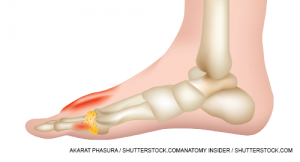 In May, the ACR released a new treatment guideline for the management of gout for simultaneous publication in Arthritis & Rheumatology and Arthritis Care & Research.1 Based on evidence from more than 130 published studies, the guideline makes a total of 42 recommendations—of which 16 are strong: It has 27 recommendations for urate-lowering therapy (ULT) management (of which 13 are strong), five each for managing gout flares and lifestyle recommendations, four for management of other medications for gout patients and one for asymptomatic hyperuricemia management. The previous ACR gout guidelines were published in 2012.
In May, the ACR released a new treatment guideline for the management of gout for simultaneous publication in Arthritis & Rheumatology and Arthritis Care & Research.1 Based on evidence from more than 130 published studies, the guideline makes a total of 42 recommendations—of which 16 are strong: It has 27 recommendations for urate-lowering therapy (ULT) management (of which 13 are strong), five each for managing gout flares and lifestyle recommendations, four for management of other medications for gout patients and one for asymptomatic hyperuricemia management. The previous ACR gout guidelines were published in 2012.
The guideline was developed using GRADE (Grading of Recommendations Assessment, Development and Evaluation) methodology and included input from an eight-patient panel and consideration of therapies’ cost based on average wholesale pricing for each drug, according to John D. FitzGerald, MD, PhD, co-principal investigator of the new guideline, past chair of the ACR’s Quality of Care Committee and a rheumatology researcher at the University of California, Los Angeles (UCLA), David Geffen School of Medicine. To assess risk of bias of evidence, guideline investigators used the Cochrane risk-of-bias tool for randomized controlled trials and the ROBINS-I (Risk of Bias in Non-Randomized Studies of Interventions) tool for observational studies.
New Strong Recommendations
Sixteen strong recommendations included changes from the 2012 guidelines. New clinical data reinforce the now strong recommendation for following a treat-to-target strategy of dose management when treating all gout patients with serum urate-lowering therapy (ULT). To limit potential side effects (including gout flare with ULT initiation), initiating low-dose ULT is recommended, with subsequent dose titration guided by serial serum urate values to achieve a serum urate target of 6 mg/dL.
Other strong recommendations include:
- Initiating ULT in gout patients with one or more subcutaneous tophi over no ULT;
- Initiating ULT in patients with radiographic damage, using any modality, that is attributable to gout;
- Initiating ULT in patients with frequent gout flares, or two or more per year;
- Use of allopurinol as the first-line ULT, including in gout patients with stage 3 or worse chronic kidney disease;
- When using allopurinol or febuxostat as ULT, starting at low dose, with subsequent dose titration to target over a higher dose (e.g., 100 mg/day or less for patients taking allopurinol or a lower dose for patients with chronic kidney disease, and 40 mg/day or less for patients taking febuxostat);
- Use of concomitant anti-inflammatory prophylaxis over no prophylaxis when patients start ULT for at least three to six months, rather than less than three months, with evaluation and continued prophylaxis if the patient keeps having flares;
- Use of colchicine, non-steroidal anti-inflammatory drugs or glucocorticoids as appropriate first-line therapy for gout flares over interleukin (IL) 1 inhibitors or adrenocorticotropic hormone;
- When colchicine is the chosen agent for managing a gout flare, use of low-dose over high-dose colchicine given its similar efficacy and fewer adverse effects; and
- For patients with gout who have failed to achieve serum urate targets with xanthine oxidase inhibitors (XOIs), uricosurics and other interventions, and who have frequent gout flares or non-resolving tophi, switching to pegloticase over continuing the current ULT.
HLA-B*5801 Testing & More
Conditional recommendations that are new compared with the 2012 guidelines include testing for HLA-B*5801 in Black patients and for certain populations of Asian descent (e.g., Han Chinese, Korean, Thai) before starting allopurinol, due to the higher prevalence of this gene in these populations, but not testing for HLA-B*5801 in all other gout patients.
A new conditional recommendation is for an augmented ULT protocol, including patient education and shared decision making, to be managed by a non-physician healthcare provider to optimize the patient’s treat-to-target strategy.
Lifestyle management advice for all gout patients, regardless of disease activity, includes a conditional recommendation for limiting alcohol, purine and high-fructose corn syrup intake, and a conditional recommendation against adding vitamin C supplementation to therapy.
For patients with gout taking their first XOI monotherapy at the maximum tolerated or U.S. Food & Drug Administration-indicated dose who are not at their serum urate target and/or have continued frequent gout flares or non-resolving subcutaneous tophi, the authors conditionally recommend switching the first XOI to an alternate XOI agent over adding a uricosuric agent.
For patients who have failed XOIs, uricosurics and other interventions, and who have frequent gout flares or non-resolving subcutaneous tophi, a strong recommendation is made to switch to pegloticase. In the absence of frequent attacks and no tophi, then the strong recommendation is against switching to pegloticase.
Frequent Updates Reflect New Evidence
Data published after 2012 supported several important changes, says co-principal investigator Tuhina Neogi, MD, PhD, rheumatology section chief and professor of medicine at Boston University School of Medicine. Recent trials that panelists used to support recommendations include a 2017 randomized, controlled trial on the benefits of febuxostat in patients with early gout and infrequent flares; the 2018 CARES Trial, which compared the cardiovascular safety of febuxostat and allopurinol; and a 2019 study on the benefits of nurse-led gout care, which supported the conditional recommendation for augmenting ULT with evaluation by a non-physician healthcare provider.2-4
The ACR’s methodological approach to guideline development, which includes consideration of the totality of the literature, may differ from other societies, she says. The ACR’s recommendations are made largely on the basis of quality of evidence (among other factors), and strong recommendations are usually based on the results of randomized, controlled trials. But Dr. Neogi says, “some specialty societies will only make recommendations in the context of randomized trials. We don’t have randomized trials to address every single clinical question of relevance. We need to be able to look at other evidence to help develop actionable guidelines.”
Susan Bernstein is a freelance journalist based in Atlanta.
John D. FitzGerald, MD, PhD, is clinical chief of rheumatology at the University of California, Los Angeles, and physician researcher at Veteran Affairs Greater Los Angeles Medical Center.
2020 Gout Guideline Updates
Updates from the earlier guideline include:
- Indications for starting ULT have been expanded to conditionally consider patients with infrequent gout flares or after their first gout flare if they also have moderate to severe chronic kidney disease (CKD stage ≥3), marked hyperuricemia (serum urate >9 mg/dL) or kidney stones.
- Allopurinol is strongly recommended as the first-line ULT, including in patients with chronic kidney disease.
- Anti-inflammatory prophylaxis (e.g., colchicine, NSAIDs, prednisone/prednisolone) when starting ULT is now three to six months, with ongoing evaluation and continued prophylaxis as needed if the patient continues to experience flares.
- HLA-B*5801 testing has been expanded to conditionally recommend testing for Black patients and for patients of Southeast Asian descent (e.g., Han Chinese, Korean, Thai) with gout.
References
- FitzGerald JD, Dalbeth N, Mikuls T, et al. 2020 American College of Rheumatology guideline for the management of gout. Arthritis Rheumatol. 2020 Jun;72(6):879–895.
- Dalbeth N, Saag KG, Palmer WE, et al. Effects of febuxostat in early gout. Arthritis Rheumatol. 2017 Dec;69(12):2386–2395.
- White WB, Saag KG, Becker MA, et al. Cardiovascular safety of febuxostat or allopurinol in patients with gout. N Engl J Med. 2018 Mar 29;378(13):1200–1210.
- Doherty M, Jenkins W, Richardson H, et al. Efficacy and cost-effectiveness of nurse-led care involving education and engagement of patients and a treat-to-target urate-lowering strategy versus usual care for gout: A randomised controlled trial. Lancet. 2018 Oct 20;392(10156):1403–1412.
Updated on Feb. 23, 2021, to reflect the erratum issued for the original guideline article.
Updated on June 30, 2020, to reflect a clarification in the sidebar.


